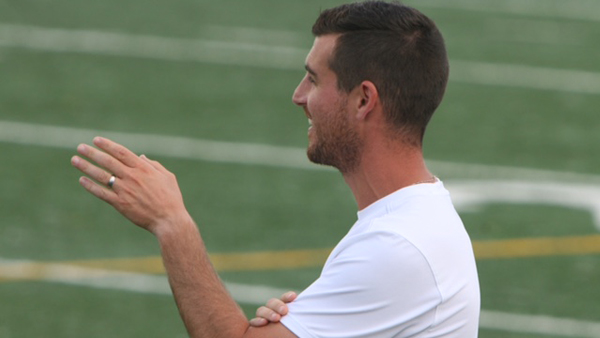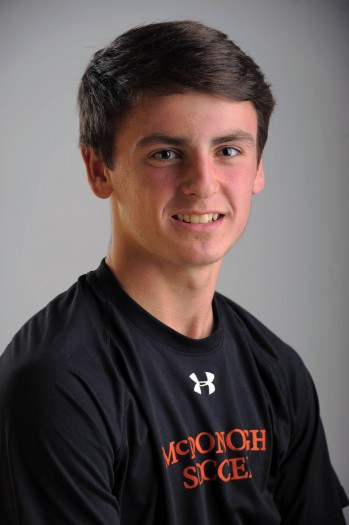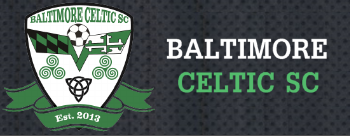SW Q&A: Brandon Quaranta talks DA, high school and more – “Celtic’s not going to be part of Baltimore Armour”

A matter of hours after our conversation with John Ellinger about new U.S. Soccer Development Academy program Baltimore Armour was published last week, a message from Brandon Quaranta hit my inbox.
Quaranta, the director of coaching at Baltimore Celtic, had read about Ellinger’s hopes of involving Celtic in the multi-club partnership that birthed Armour, a project intended to gather the area’s top talent in a more competitive, more effective DA program. And he wanted to send a clear message to Ellinger and the Maryland soccer community as a whole:
No high-school soccer allowed in the DA means no Baltimore Celtic in the DA.
Created in the aftermath of U.S. Soccer’s policy banning DA players from taking part in high-school play, Celtic explicitly welcomes those who wish to balance both club and school involvement. And it’s proved to be quite a compelling alternative to Bays Chelsea, the region’s incumbent DA club, with an exodus of talent making Celtic into a powerhouse almost instantly, while Bays have lost a bit of the luster of old.
+READ: SW Q&A: John Ellinger explains Baltimore’s new Development Academy superclub
Quaranta and I spoke about this and more over the weekend, during which time Celtic’s Under-18s scrimmaged their counterparts from D.C. United’s DA squad.
SoccerWire.com: So it sounds like you had some issues with John Ellinger’s remarks. Why isn’t Celtic interested in being part of the Development Academy and all the opportunities it offers?
Brandon Quaranta: John reached out to me back in the fall and we had a cordial conversation … I respect what he’s trying to do, but it just wasn’t right for our membership at this point. Will that ever change down the line? Who knows, but at this point that’s where we are. We’ve been very consistent about our message that high-school soccer is important to our players and our families, and we want to continue to give them the opportunity to do that. This all kind of ended at that point in the fall, and we moved on. … I just want to get out this message to my families, that Baltimore Celtic’s not going to be part of Baltimore Armour this coming season.
SW: Would it change your perspective if the federation provided Armour with more waivers to its no-high-school policy, in recognition of Baltimore’s unique situation?
BQ: It’s hard to comment not knowing what U.S. Soccer would be thinking along those lines. I’ve been involved with the academy system and I coached in the academy for several years with Steve Nichols. We were involved in the waiver process, we tried to make it work for our players, and really, it’s very difficult. It’s not just the numbers situation. Really, the way it’s structured, it puts players in a bad position, it puts the coaches in a bad position who try to do both.
 The knock from the outside is that we’re anti-[Development] Academy, we’re anti-U.S. Soccer. That could not be further from the truth. We’re huge U.S. Soccer fans. We’re the group that has Keegan Kelly in the full [Bradenton] Residency program, we’re the group that has a handful of other guys in the national pool. We want to continue to produce those players. We want Celtic to be a big part of trying to make American soccer one of the powers in the world. We want to produce players for the national teams. We want to produce players that can help our World Cup team down the line. So that perception is a little off.
The knock from the outside is that we’re anti-[Development] Academy, we’re anti-U.S. Soccer. That could not be further from the truth. We’re huge U.S. Soccer fans. We’re the group that has Keegan Kelly in the full [Bradenton] Residency program, we’re the group that has a handful of other guys in the national pool. We want to continue to produce those players. We want Celtic to be a big part of trying to make American soccer one of the powers in the world. We want to produce players for the national teams. We want to produce players that can help our World Cup team down the line. So that perception is a little off.
John got this part right: The Baltimore market is unique. It’s one of the only a couple of markets in the United States where high-school soccer is really important, high-school soccer is at a very high level and the kids want to play. We were in position where we were having to go to some of our players, saying, “We can waive you [from no-high-school policy” for A, B and C reasons, then go to another, equally talented player, and say “you have to make a choice.”
For me being in that position personally, I didn’t like players having to make that decision. It was too messy for me, hence the reason we started Celtic, and said, “listen, this isn’t anti-Academy, this is just providing another environment, another outlet for players who want to go a different route.” Players who still want to play really high-level soccer, players who want to be involved in high school, players who want to go to top colleges. Here’s another way you can do it. We’ve been consistent with that message from day one.
SW: When Celtic was founded, Nichols told us that he believed he could create a club schedule as competitive as a DA program’s, but without forcing kids to quit their high-school teams. Two years later, how do you think it’s gone?
BQ: First and foremost, the academies got it right: You have to create a competitive training environment several days a week where talented player pools are competing and going after each other. And the No. 1 way we’re able to do that, we’ve been lucky to attract the best players – and coaches, for me – in the Baltimore area. We have access to great facilities, both at McDonogh and at other schools where we can get them proper fields, proper equipment.
 From a schedule standpoint, we’re playing in the [US Youth Soccer] National League, we’re playing in the regional league, we’re getting creative outside of those leagues in trying to find high-quality games, including today – our 17/18s are playing against D.C. United’s 18s. The coaches at D.C. that are in the [Development] Academy have expressed interest in getting quality games to play against.
From a schedule standpoint, we’re playing in the [US Youth Soccer] National League, we’re playing in the regional league, we’re getting creative outside of those leagues in trying to find high-quality games, including today – our 17/18s are playing against D.C. United’s 18s. The coaches at D.C. that are in the [Development] Academy have expressed interest in getting quality games to play against.
We played Bethesda[-Olney], we’ve played D.C., we’ve set up other competitive games against academy groups. So really in a lot of ways, we’re getting the best of both worlds … We’re going to have to continue to be creative and find ways for our players to get games that are necessary for their development. But so far we’ve been able to do that, our player pool is very happy with the level of games they’ve gotten. We’ve just got to continue to stay ahead of the curve.
SW: One of the unique elements of the Baltimore scene is its intimacy and interconnectedness – for example, your cousin Santino is involved in Baltimore Armour. Does that create more stress in this situation?
BQ: If you’re going to be a high-level player, high-level coach, high-level organization, you need to thrive on competition. I think our groups always thrive on competition. Saying that, I think too many clubs – and that goes for the entire country, and especially in this region – are too reactionary. They worry too much about other groups and what they’re doing and how that affects them. For us it’s about improving our product.
 We’re two years into this thing, and we won a national championship last year. We have two teams that have qualified for nationals already this year, two winners of the National League – we’re the only club in the country that has two winners of that division – and we’ve got five or six guys in the national pool. We continue to put guys in top colleges. But we know we’re only two years into a process that we know will be decades of soccer success.
We’re two years into this thing, and we won a national championship last year. We have two teams that have qualified for nationals already this year, two winners of the National League – we’re the only club in the country that has two winners of that division – and we’ve got five or six guys in the national pool. We continue to put guys in top colleges. But we know we’re only two years into a process that we know will be decades of soccer success.
So we need to get a lot better with what we’re doing, we need to continue to improve our product so that we can not only continue to retain the best players in the Baltimore metropolitan area, but continue to attract those players, and continue to attract the type of coaches that we have – which are all the top coaches from the University of Maryland, UMBC, Loyola. We’ve got Danny Kelly, who’s the pro coach for the Baltimore Blast. We’ve got the top high-school coaches in the area.
In my mind, one [Development] Academy team is leaving, another Academy team is coming in to replace them, with a lot of the same people involved. It doesn’t have a lot to do with how we’re conducting day-to-day business. We’re going to continue to push our message forward, our philosophy forward, and do things the way that Baltimore Celtic wants to do business. It’s different from some of those clubs and we feel that right now, in the current structure, it’s an effective way to develop our players and give our membership what they’re looking for.











